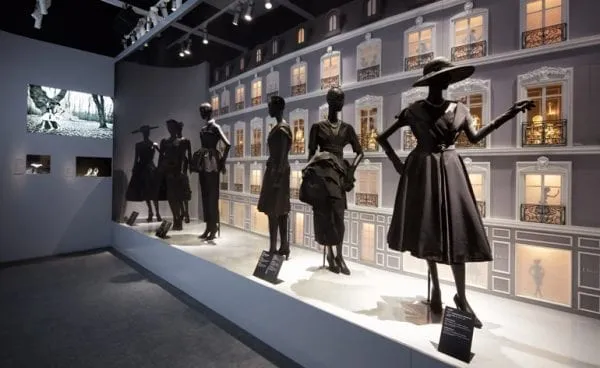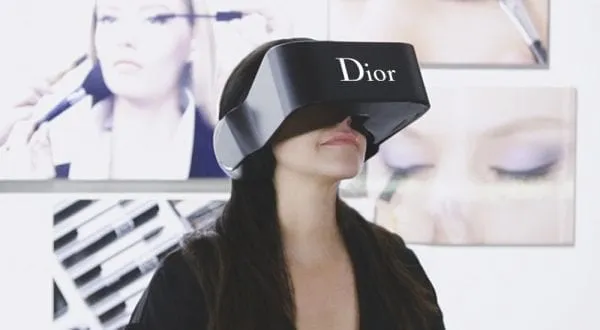
Dior is worth $42.7 billion!
It is also ranked as the 14th most valuable brand in the world.
How does Dior continue its rise to the top? In part, through clever marketing strategies focused on social engagement and content.

Dior is known for its ambitious exhibitions.
The brand presents the rich heritage and history of its dresses, perfumes, accessories and pictures in various parts of the world.
Among these exhibition is Esprit Dior, which featured the brand's history. It had 10 different themes: 'Paris,' 'Dior and his artist friends,' 'Dior Garden,' 'Dior Allure,' ‘Dior Atelier’, ‘Dior’s Stars’, ‘Versailles: Trianon’, ‘Miss Dior’, ‘From Pink to Red,' ‘J’adore’.
Another exhibition is the New Look Revolution, which featured the evolution of the Bar Suit. The iconic item first appeared in Dior's earliest collection. Not only did the exhibition feature how the item has changed, but it also featured the hard work that it took to create it.
Dior manages multiple social media accounts that appeal to a specific demographic.
The brand has two Instagram accounts the Dior official (@dior) and the Dior Homme (@diorhomme). The former is targeted to its main consumers, while the latter caters specifically to its male audience.
At present, Dior's Instagram strategy is a massive success. Its official Instagram (@Dior) has 15 million followers and (@Diorhomme) has 88 thousand followers. However, its Instagram accounts are not successful simply because it caters to niche audiences.
At Dior Homme, the brand only creates posts that cater to its male demographic. Posts that will not appeal to its male demographic, are not featured on its page.
While it takes more time and effort to manage two accounts, the brand certainly has no regrets.
“Having separate social media accounts, although the time allotted to maintain is greater, can be very beneficial to a brand as they can target messaging to that specific group of followers that may end up lost in a single ‘all things to all followers’ social media experience,” said Marci Troutman, CEO of SiteMinis in an interview.
Dior has not only conquered the hearts of Western fashionistas, but also China’s online shoppers.
The brand entered China and sold its Lady Dior bags on WeChat during the Qixi Festival Holiday. What was originally a four-day online marketing campaign became a one-day event, after the bags were immediately sold out.
"Dior produced a few hundred of the limited edition bags for the campaign, but due to high customer demand, we sold out in a day," said a staff member of Christian Dior.
WeChat greatly contributed to the campaign's online success. Prior to purchasing the product, consumers can interact with Dior's representative through the app.
"It was a good effort for Dior, and in the future, WeChat may become an important marketing channel for Dior to promote products and interact with customers. And I think many other luxury brands may follow suit to try more channels so as to reach a wider range of customers." said Liu Dingding, an independent industry analyst, in an interview.
Since ecommerce is the future of retail, Dior's move to jump in the bandwagon has proven to be the right strategy.
Dior didn't want to just offer a traditional fashion show, instead they wanted to upgrade the way their consumers see fashion. They knew that technology was key for innovating these experiences, and that is why they created Dior Eyes—a VR headset for runway shoes.
The brand partnered with DigitasLBi Labs France to create the state-of-the-art device. The product was introduced at selected Dior stores last June 2016.

What makes the VR headset a fashion innovation, is that it enables users to witness the backstage events of their runway shows. For instance, users can see models being prepped by Peter Philipps, Creative and Image Director of Dior Make-up.
By introducing VR headsets, Dior is able to make their loyal fans feel as if they have a backstage pass.
https://www.youtube.com/watch?v=2whw2ZEiLtw
To promote the Poison Girl Eau de Toilette, the brand created a dance-centric film.
The commercial features Camille Rowe who meets up with her clad of girls, to have a dance-off with a gang of boys. The commercial is followed by a series of how-to videos that teach its audience how to perform the dance steps. These short video tutorials are : Feel the Space, Warm It Up, Rise the Heat, Own the Stage and Poison Kiss.
These promotions were created with millennials in mind.
"Poison Girl [Eau de Toilette] is edgier, it’s more provocative.…She’s fresh, connected and social. That’s why we decided to launch in a different way; to really target, recruit and talk to the Millennial,” – de Lesquen, Dior’s president and chief executive officer for North America.
Dior's move to create a dance-themed campaign was an instant hit. In fact, the brand's main video for its Poison Girl campaign has garnered 30 million views on YouTube alone.
Monique Danao is a writer and content creator with an expertise in marketing and SEO. When she's not writing, you'll find her enjoying funky food, listening to music and marketing startups.
Grow your sales at a ridiculously
lower CAC.